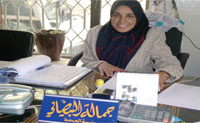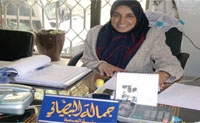
Al-Tahadi Association for Physically Disabled Women [Archives:2006/910/Last Page]
January 9 2006
 |
Change and need for more change
Al-Tahadi Association throughout its field work has helped promoting change not only in the humanitarian situation of disabled females lives, through awareness activities it has also promoted cultural and social changes in the society's attitude towards disabled people, women especially.
Disabled people were isolated especially mentally and physically handicapped people. Women in particular were hidden in homes sometimes for a lifetime as they were considered source of shame to the families. With the continuous effort of al-Tahadi's Association among other institutions families gradually started allowing their disabled family members to appear in society and participate in activities organized by the emerging specialized organizations, yet reservations still exist regarding disabled females. In addition to the social exclusion, marginalization and negative behavioral attitudes people with disabilities are subjected to by the society, there are other critical factors that highlight the significance of this issue in Yemen and confirm to the fact that there is a real problem.
– Illiteracy, as the ratio reaches as high as 97% illiterate person of the disabled population
– High cost of physical support equipment and their scarcity
– Low employment and educational opportunities
– Inconvenient infrastructure and public transportation
– Ignorance that leads to worsening mental and physical health of the disabled, and the non availability of early intervention tools
– Limited geographical disperse of facilities
– Insufficient and inefficient training and rehabilitation courses and focus on male handicapped, which leads to low skills among them
– Economic discrimination against disabled people in terms of loans, project funding and economic credibility
The Association
Background
The Association was established in 1998 as a women's committee of an organization targeting disabled males. After a long struggle the committee branched out and formed an independent association of 30 members dedicated to disabled women's issues in Yemen. The foundation period was very challenging and the association lead by Ms. Gamala al-Baidhani faced many challenges in a male dominated world. Yet, the group of young activists decided to challenge all the obstacles and fight their way through, representing themselves through al-Tahadi Association “Challenge”, forming by that the very first specialized non government organsiation in this field. Today al-Tahadi Association includes 557 members of young women 135 of which are born with physical disabilities.
The Association is composed of the administration committee and this consists of 11 women with movement disabilities. A monitoring committee of five women with movement disabilities. A fixed advisory body of eight officially allocated personnel five of which are males and three females, this committee are government officials, parents and guardians as well as donor representatives. And finally a volunteering committee of 70 physically healthy young men and women whose interest are the well fare of the society and who are engaged in several of the Associations activities and campaigning.
Organizational capacity and administration efficiency
Al-Tahadi Association has invested in both human resources and institutionalization and structure in the same time. Results of this strategy lead to qualifying the Association's staff in management, and supervision of the Association's activities in addition to qualifying 15 vocational trainers, one nurse, two computer tutors and 3 literacy teachers. Institutional wise the construction of a children's club including sports facilities, a public library and in-house hostels and accommodation for 30 disabled females was accomplished.
Regular activities
– Management of the deaf and dumb and mentally disabled government center
– Handicraft and vocational training ongoing courses including sewing, recycling and toys and puppet creation
– Literacy classes
– Children's library and club
– Computer literacy classes
– Provision of transportation for the participants and students
Capacity Building
This includes training, building capacity of the staff and beneficiaries as well as education:
– Facilitating the employment of 15 disabled females in government offices
– Teaching 170 disabled woman reading and writing
– Qualifying 120 disabled females in handicrafts and various income generating skills
– Formal adult education for disabled females who know how to read and write
– Computer literacy of 80 disabled females
– Pre-school integration programs for 20 children every year
Sports and physical therapy for students all year round
Medical and equipment support
– Provision of 1200 wheelchairs granted from various donors
– Provision of 500 clutches for disabled people
– Facilitating the provision of 2500 case of artificial limps or disability aids
– Facilitating 13 rectification operation for children below one year of age
– Facilitating 170 mild disability operation for people in the rural areas
Income generating
And this takes place through playing an intermediate role between the productive disabled females who have been trained through the Association and the market so as to enable the women to earn from their work. The Association also plays a vital role in networking and society awareness to assist acceptance of disabled women and their financial credibility.
Advocacy, awareness and networking
– Follow up of the government decree number 407 for year 1999 that allows disabled children to enroll in schools and support in their integration in schools
– Direct awareness programs in 4 hospitals, 41 schools, 11 ministries, 6 companies, 7 banks and several factories in addition to media campaigns
– Creation of an alliances support group of 30 rural associations who play an intermediate role in conveying our services to more than 3000 case of disability.
Early interventions
Through our visits to families during our awareness work we realized around 30 cases of children below one year of age who display signs of disability and which could be helped if intervention took place immediately. The Association then realized a new scope for our work and while it supported the 30 cases discovered, we launched an awareness project in order to assist further cases. Today the Association is directly responsible for the treatment of 20 more children between 1-5 years old while there is a waiting list of 40 cases of which 30 are female children.
——
[archive-e:910-v:14-y:2006-d:2006-01-09-p:lastpage]


